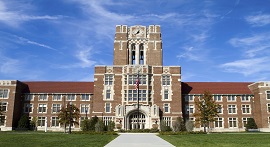Physician Assistant
Overview
Physician assistants are involved in a broad range of medical services, working in private practices, hospitals, nursing homes, student health services, health maintenance organizations, and public clinics. Physician assistants are formally trained to assess patient needs and make referrals to the proper physician. They also care for patients when a doctor is unavailable, write prescriptions, administer drugs, treat minor injuries, and handle administrative tasks. Most physician assistants work in primary care fields, such as pediatrics and family medicine, although some work in specialty areas as well.
Physician Assistant graduate programs range from one to three years in length. Typically, students spend the half of the program in the classroom with the second half spent doing clinical work in various medical environments. Programs focus on learning to evaluate, diagnose, and manage acute and chronic conditions in patients. Students will be required to understand basic principals of anatomy, pharmacology, clinical medicine, health care, and clinical decision-making. A good deal of time is dedicated to developing an understanding the human body, but it’s equally important that students learn the skills needed for handling the psychology of their patients – especially those in trauma.
While Physician Assistant graduate programs are shorter than graduate programs in allopathic (M.D.) and osteopathic (D.O.) medicine, they offer the opportunity to be intimately involved in primary care of patients.
Degree Information
The P.A.-C. (Physician Assistant-Certified) degree is conferred by accredited Physician Assistant programs. It takes one to three years to complete.
Questions to Ask Yourself When Choosing a Degree Program
- What is the school's educational mission or focus? What medical specialties can students pursue?
- Where will I do my clinical rotations? What is the quality of the associated hospital, clinic, or teaching facilities?
- Is the school’s setting rural or urban? How does the school’s location influence the patient-base?
- How is clinical time divided?
Career Overview
Physician assistants (P.A.s) provide diagnostic, therapeutic, and preventative healthcare services under the supervision of physicians. Though their scope of practice varies state to state, P.A.s are licensed to work in a broad range of primary care services. For example, all physician assistants may take medical histories, examine patients, order laboratory tests and x rays, and make diagnoses. They treat minor injuries, record progress notes, counsel patients, and order therapy. In 47 states and the District of Columbia, physician assistants may prescribe medications.
In a hospital, physician assistants may serve as a liaison between doctors and nurses or supervise technicians and assistants. In a rural or inner city clinic, a P.A. may work as the primary care provider under the supervision of a physician who is only present one or two days per week. P.A.s may also make house calls or nursing home visits to check on patients and report back to the physician.
According to the Department of Labor, physician assistant jobs are growing at a rate that is much faster than average. Job opportunities are expected to increase 36 percent or more over the next ten years.
Career/Licensing Requirements
In order to become a practicing physician assistant in the United States, you must be certified by the National Commission on Certification of Physician Assistants (NCCPA). To earn certification you must graduate from an accredited university and pass the Physician Assistant National Certifying Examination (PANCE). Certification must be renewed every six years.
Salary Information
Starting physician assistants can expect to make around between $30,000 and $-50,000 depending on the practice setting.
Related Links
American Academy of Physician Assistants
The American Academy of Physician Assistants has information for students and current physician assistants. The site also offers information on upcoming conferences and employment opportunities.
Association of Physician Assistant Programs
The Association of Physician Assistant Programs is a national organization representing physician assistant programs in the United States.
National Commission of Physician Assistants
Get certified by the National Commission of Physician Assistants. Learn about the process and get the latest news in the physician assistant world.
Central Application Service for Physician Assistants
The Central Application Service for Physician Assistants is a centralized, web based application service for a number of physician assistant programs.
MAJORS
RELATED GRADUATE PROGRAMS
RELATED CAREERS
SAMPLE CURRICULUM
Pathology
Behavioral Medicine And Psychiatrics
Biostatistics
Clinical Decision Making
Clinical Medicine
Dermatology
Epidemiology
Health Care Ethics
Health Care Management
Human Anatomy
Human Physiology
Infectious Diseases
Medical Nutrition
Neurology
Pa Role And History
Pharmacology
Physical Examination
Radiology
Research Design And Methodology
Surgery
Twelve Months Of Clinical Work
Featured MBA Programs For You
Connect with business schools around the globe and explore your MBA options.

Best Business Schools
Check out our lists of best on-campus and online MBA programs and find the best program for your career goals.
Explore Graduate Programs For You
Ranked master’s programs around the globe are seeking students like you to join their programs.
Med School Advice
Get medical school application advice, USMLE prep help, learn what to expect in med school and more.


